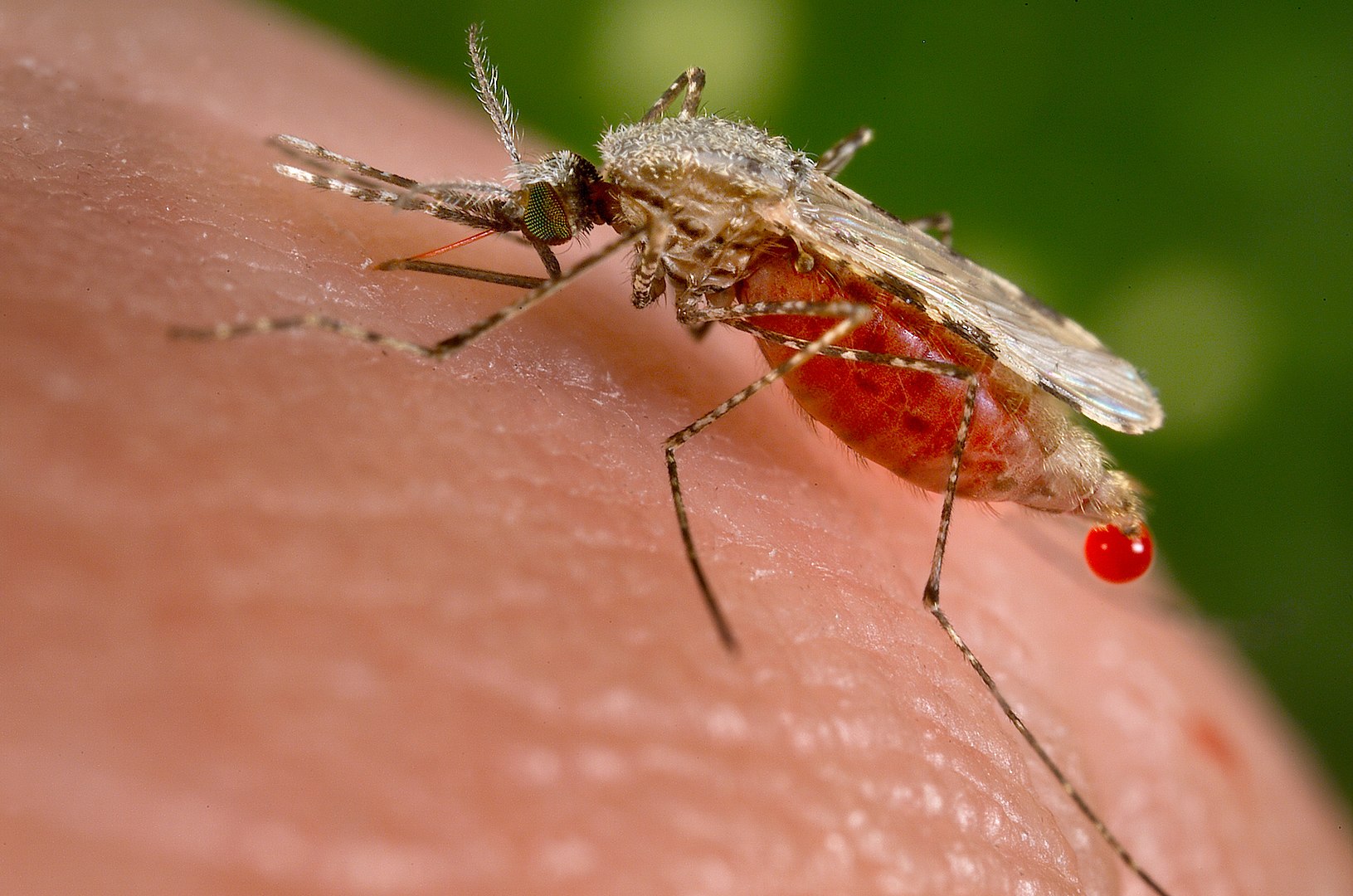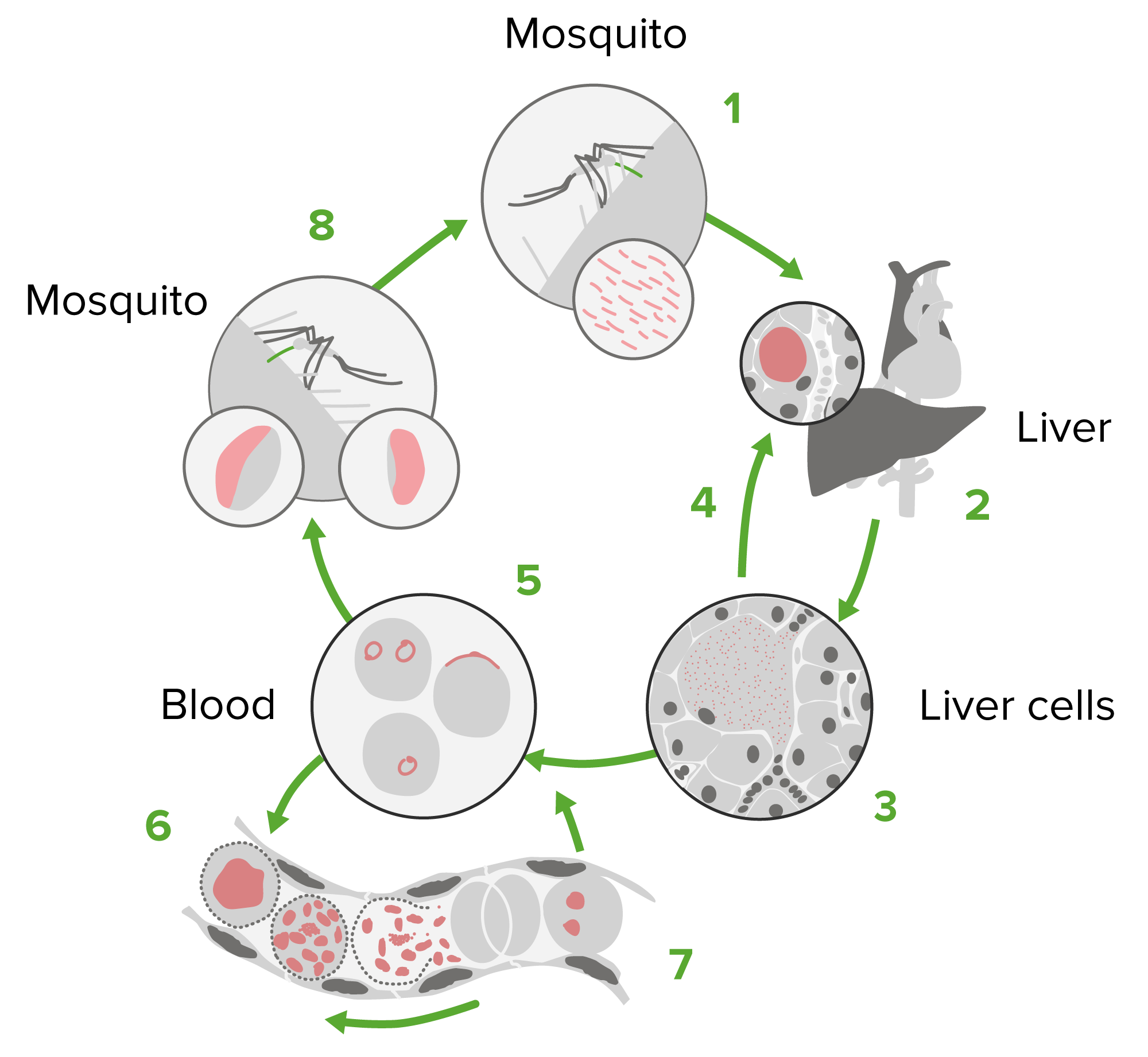Playlist
Show Playlist
Hide Playlist
Malaria – Protozoa (Hematologic Infection)
-
Slides 10 Plasmodium MicrobiologyAdvanced.pdf
-
Download Lecture Overview
00:01 Some of the symptoms of malaria include fever and paroxysms of shaking chills, and of course anemia, as the parasites multiply in red blood cells and destroy them. 00:14 The paroxysms coincide with lysis of red blood cells, which of course is done to release the merozoites, this causes the production of cytokines and the waves of fever so characteristic of the disease. 00:29 Sometime the replication of the parasites within the blood cell is synchronized, remember your body's full of many, many red blood cells but they can all be, or many of them can be infected with malaria parasites and they can all mature at the same time and rupture at the same time in cycles, and a characteristic feature of malaria is this bouts of fever that occur in cycles as all these red blood cells burst at more or less, the same time. 01:00 Other organs may also be involved in malaria besides the liver and the red blood cells, and this can result in hemolysis which leads to icterus and jaundice, effects on the liver and enlarged spleen, particularly as a consequence of trapping of infected red blood cells. 01:21 Now, normally, a red blood cell is very deformable, it can move through tight spaces like capillaries and organs very readily, but when they are infected with malaria parasites they become less deformable, they get trapped in organs with small capillaries like the spleen and that causes disease. 01:40 Now, the four different species of malaria that I mentioned to you at the beginning of our talk differ in their virulence, all four of them were shown in their blood forms here, and depending on where you are when you get infected you can have a somewhat different outcome. 01:56 The long-term effects of repeated infections which can happen because immunity is not protective, you may have learning deficits, a reduce growth rate, and in pregnant women, can lead to spontaneous abortion. 02:11 So this is one of the tragedies of malaria in kids, young kids who get repeatedly infected over and over, they feel miserable for months at a time, they can't learn properly and they can't go on to be productive adults in society. 02:26 How do you diagnose malaria? One way is to take a little bit of peripheral blood and to stain it and look for the blood forms that we have just talked about. 02:35 On the right is a microscope slide on which we've made a thin or a thick film of blood, we've simply smeared the blood out and a thick film has more cells in it so you have better chance of seeing what you're looking for, you can stain it and look for the malaria parasites. 02:52 Plasmodium falciparum displays these blood forms shown on the right, there are 20-30 some odd different blood forms starting from number one at the upper left all the way down to the lower right and you can see many of these but not all of them in peripheral blood because some of them are restricted to organs. 03:11 So in peripheral blood, you can readily see stages 1 to 15 and 27 through 30. 03:19 And in some of the slides we've looked at, you can see some of these, and a good exercise would be for you to go back and look at the slides I've shown you and see if you can pick out what blood form it is. 03:28 Natural infection -- natural immunity to infection, is imperfect, you're not protected, even though you do respond, you are not protected against reinfection, so this is the hallmark of malaria, throughout your whole life if you lived out in an endemic area, you will be re-infected over and over and over again, and as I said, this leads to a miserable life in which you can't do anything productive. 03:57 How do you treat malaria? Chloroquine was once the drug of choice. 04:01 It was an amazing wonder drug that could get rid of malaria instantly. 04:06 The way it works is it blocks heme detoxification in red blood cells, so when the parasites are replicating in red blood cells, they wanna break apart heme and to get the iron part out, the heme itself is toxic, the malaria wants to break it down, this drug prevents that detoxification that results in killing of the parasite. 04:28 However, the use of this drug over many years led to extensive resistance so it's not really useful, not anymore. 04:35 Fortunately, we do have other drugs like mefloquine, malarone, quinine, halofantrine, and the artemisinins, the later, very effective drugs can be modified in ways to make derivatives. 04:50 Recently, their discovery was recognized with a Nobel Prize. 04:55 How do you prevent infection? This is sometimes a good way to not have to use an anti-malarial drug, now you can engage in mosquito control and try and spray for mosquitoes. 05:10 This isn't always practical and we have limitations on what insecticides we can use, but that's one possibility. 05:16 Mosquito nets like this one on top of the bed. 05:20 It's a very simple way to avoid being bitten at night, the time in which many mosquitoes prefer to bite. 05:27 However, during the day you're out and about, you're still going to be bitten during the day, so this doesn't solve all the problems. 05:34 These nets over the bed can also be sprayed with insect repellant. 05:37 You can wear insect repellants on your body during the day and you can cover your body with clothing. 05:43 You can wear long-sleeved shirts and long pants with the pants tucked into your socks and that leaves just your face which you could cover with repellant to keep the mosquitoes off. 05:54 You can also put screens in your windows, this is an amazing low-tech solution. 05:59 Many of the homes and areas endemic for malaria have open widows with no screens on them; the mosquitoes come and go as they wish. 06:06 A simple thing like a window screen cuts down on the incidence of malaria. 06:12 We may think that this is nothing but in our world, screens are usual, but not everywhere. 06:17 Now, this is such an important disease that not only are people are trying to develop new antimalarial compounds, but new vaccines of all sorts of different types are under development and I think some time in the next 5 to 10 years or so, with a lot of funding from the Gates Foundation, these vaccines will become a reality.
About the Lecture
The lecture Malaria – Protozoa (Hematologic Infection) by Vincent Racaniello, PhD is from the course Parasites.
Included Quiz Questions
Which of the following species of Plasmodium does NOT cause malaria in humans?
- Plasmodium sporozoite
- Plasmodium falciparum
- Plasmodium vivax
- Plasmodium malariae
- Plasmodium ovale
Which of the following drugs is NOT currently being used to treat malaria?
- Chlordiazepoxide
- Mefloquine
- Malarone
- Quinine
- Halofantrine
Which of the following is NOT a strategy currently available to prevent contracting malaria?
- Getting an antimalarial vaccine
- Wearing insect repellent on the body during the day
- Having a mosquito net over the bed at night
- Covering the body with clothing
- Putting screens on windows
Which of the following is true about the spread of malaria?
- It is transmitted through the bite of an infected female Anopheles mosquito.
- There are animal variants of malaria that cause human disease.
- There are three different strains of Plasmodium that cause malaria in humans.
- The use of artemisinin medications to treat malaria has led to the development of resistance.
- A window screen does not cut down on the likelihood of contracting malaria.
Which cells in human blood are most affected by Plasmodium?
- Red blood cells
- Lymphocytes
- Natural killer cells
- Macrophages
- Platelets
Why does splenomegaly develop in patients infected with malaria?
- Entrapment of RBCs in the spleen
- Increase in growth hormone levels
- Increase in production of RBCs
- Abnormal tissue repair
- Increase in blood pressure because of low RBC levels
Which stain is commonly used to detect Plasmodium in a peripheral blood smear?
- Giemsa stain
- Ziehl-Neelsen stain
- Haematoxylin and eosin stain
- Methenamine silver stain
What is the mechanism of action of chloroquine?
- It blocks heme detoxification in red blood cells.
- It blocks H2O2 production.
- It blocks the G6PD enzyme.
- It acts as a precursor of glutathione.
- It blocks dihydrofolate reductase.
What part of the red blood cell does Plasmodium require to develop?
- Iron
- Heme groups
- Globulin protein
- Mitochondria
- Cell adhesion glycoproteins
What is the best way to prevent malarial infection during the night?
- Bed nets
- UV night lamps
- Infrared night lamps
- Methotrexate as prophylaxis
- Primaquine as prophylaxis
What is the best way to prevent malarial infection for people at home?
- Installing window screens
- Giving primaquine as prophylaxis to the family
- Giving sulfamethizole as prophylaxis to the family
- Spraying parathion around the property
- Spraying malathion on the windows and doors
How many types of malarial strains can be transmitted to humans by mosquitoes?
- 4 or 5
- 2
- 3
- 8
- 6
Which organism is a vector of Plasmodium that causes disease in humans?
- Female Anopheles mosquito
- Male Anopheles mosquito
- Sporothrix schenckii
- Ixodes scapularis
- Mansonia mosquito
Customer reviews
5,0 of 5 stars
| 5 Stars |
|
1 |
| 4 Stars |
|
0 |
| 3 Stars |
|
0 |
| 2 Stars |
|
0 |
| 1 Star |
|
0 |
the lecturer is very good in lecturing, i understand very well morethan in the class hall





